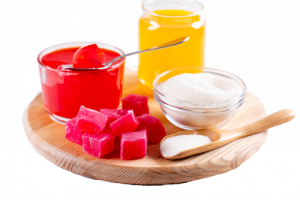Are you ready to take your cooking to the next level? Imagine turning your classic recipes into culinary masterpieces by using some new and exciting pantry items. In this article, we’ll delve into the world of hydrocolloids, the secret ingredients that can transform your dishes with improved flavors and textures. If you’re tired of the usual thickeners like flour and corn starch, it’s time to discover the wonders of hydrocolloids.

Understanding Hydrocolloids:
The Magic in Your Pantry. You might be wondering, what exactly are hydrocolloids? Simply put, they are substances derived from natural sources, such as plants and seaweeds, that have the incredible ability to thicken and stabilize liquids. They work by absorbing water and forming a gel-like consistency, which can enhance the texture and mouthfeel of your dishes.
Imagine your soups becoming creamier, your sauces silkier, and your desserts achieving that perfect, spoonable consistency. Hydrocolloids are the magic ingredients that can make it all happen.
Benefits of Using Hydrocolloids in Your Cooking Adventures:
The benefits of using hydrocolloids in your cooking are numerous and impressive. Unlike traditional thickeners, hydrocolloids offer improved stability and viscosity, ensuring that your dishes maintain their desired texture even when subjected to different temperatures and cooking techniques. Whether you’re cooking a hot stew or a chilled dessert, hydrocolloids have got you covered.
Think about the last time you prepared a sauce that separated or a dessert that turned out too watery. With hydrocolloids, those problems can become a thing of the past. Your culinary creations will not only taste better but also look more visually appealing.

Common Hydrocolloids:
Your New Culinary Arsenal. Now that we’ve piqued your interest, let’s take a closer look at some of the most common hydrocolloids that can revolutionize your recipes:
Agar Agar: Derived from seaweed, agar is a versatile hydrocolloid that can be used to create everything from solid gels to creamy textures. Use it to set your jams and jellies or to create stunning layered desserts.
Carrageenans: Extracted from red seaweed, carrageenans are renowned for their ability to provide a smooth and velvety texture. They are perfect for thickening dairy-based recipes like custards and ice creams.
Locust Bean Gum: This hydrocolloid is sourced from the seeds of the carob tree and is an excellent natural thickener. It’s often used in gluten-free recipes to achieve a desirable consistency in sauces and dressings.
Guar Gum: Derived from guar beans, this hydrocolloid is a powerful thickener and stabilizer. It’s ideal for improving the texture of sauces, gravies, and even gluten-free baked goods.
Xanthan Gum: A popular choice for both gluten-free and keto recipes, xanthan gum is derived from fermented sugars from corn. It’s an exceptional stabilizer and thickener, perfect for achieving the right consistency in sauces, dressings, and bakery items.
Elevating Your Classic Recipes with Hydrocolloids
Now that you’re acquainted with these hydrocolloids, you might be wondering how to use them in your favorite recipes. The process is simpler than you might think! By substituting traditional thickeners with hydrocolloids, you can achieve smoother textures, prevent separation, and elevate the overall culinary experience. Below is a recipe example. It is delicious with flavors and textures enhanced beyond what can be accomplished with traditional ingredients.
Creamy Vegan Chocolate Pudding with Agar Agar
Ingredients:
2 cups coconut milk (full-fat)
1/3 cup cocoa powder
1/4 cup maple syrup
1 tsp vanilla extract
1/4 tsp salt
1 tsp agar agar powder
Fresh berries, for garnish
Chopped nuts, for garnish
Gravy boat of rich and creamy gravy- guar gum enhances the velvety texture of gravies.
Instructions:
STEP1. In a saucepan, whisk together the coconut milk and cocoa powder over medium heat until well combined and slightly warm.
STEP 2. Add the maple syrup, vanilla extract, and salt to the saucepan. Continue to whisk until the mixture is smooth and heated through.
STEP 3. Sprinkle the agar agar powder evenly over the mixture while continuously whisking to prevent any lumps from forming.
STEP 4. Bring the mixture to a gentle boil, then reduce the heat to low and simmer for 5-7 minutes. Make sure the agar agar is completely dissolved.
STEP 5. Remove the saucepan from the heat and allow the mixture to cool for a few minutes. It will start to thicken slightly as it cools.
STEP 6. Carefully pour the pudding mixture into individual serving cups or ramekins. You can use fun shapes for added appeal.
STEP 7. Refrigerate the puddings for at least 1-2 hours, or until they are fully set and have a creamy consistency.
STEP 8. Once the puddings are set, garnish them with fresh berries and chopped nuts for added texture and flavor.
STEP 9. Serve the vegan chocolate pudding chilled and enjoy its velvety texture and rich cocoa flavor.
Conclusion
Incorporating hydrocolloids into your cooking repertoire opens a world of possibilities. Your dishes will not only taste better but also look more appealing, inviting everyone to indulge in your culinary creations. Say goodbye to lackluster textures and hello to newfound kitchen confidence. Experiment with these hydrocolloids and watch as your classic recipes become extraordinary culinary triumphs.
Frequently Asked Questions about Hydrocolloids
- What are hydrocolloids, and how do they work in cooking?
- Hydrocolloids are substances that can thicken and stabilize liquids. They work by absorbing water and forming a gel-like consistency, enhancing texture and mouthfeel in dishes.
- Where can I find hydrocolloid products for my recipes?
- Hydrocolloids are available in specialty food stores, health food shops, and online retailers.
- How do I determine the right amount of hydrocolloid to use in a recipe?
- Start with small amounts and gradually increase until you achieve the desired consistency. The specific recommendations can vary based on the hydrocolloid and recipe.
Bowl of Rich and Creamy Gravy Guar gum enhances the velvety texture of gravies.
